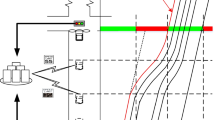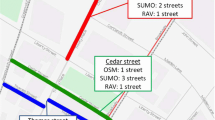Abstract
Based on the hypothesis that all vehicles on roads are floating vehicles equipped with vehicular terminals and upload their traffic information to the traffic control center in real time, many traffic flow guidance algorithms are proposed in order to improve the road capacity in Intelligent Transportation System. Based on this complete information scenario, the traffic control center can obtain all traffic information on roads and compute the guidance metrics according to the traffic flow guidance algorithm. The vehicle therefore can select the route with the guidance. However, due to the cost and technology limits, in short time, some vehicles cannot be equipped with vehicular terminals, which are non-floating vehicles and cannot upload their traffic information to the traffic control center. In this incomplete information scenario, the guidance effect will be affected by non-floating vehicles. In this paper, the method of estimating non-floating vehicles’ driving information according to floating vehicles’ information is introduced. With the estimation method, a new traffic flow guidance algorithm, Estimated Weighted Vehicle Density Feedback Strategy based on Weighted Vehicle Density Feedback Strategy (WVDFS) is proposed. In the simulation, the guidance effect of the new algorithm is performed based on the two-route scenario, which is the simplified model of traffic network. NaSch model is also used as the vehicle mobility model, which can simulate the vehicle motion. The simulation results show that non-floating vehicles have great negative influence on the performance of WVDFS, and the applicability of our algorithm is validated to have better performance in incomplete information scenarios. Our algorithm can provide solutions for current traffic flow guidance with incomplete information scenarios.








Similar content being viewed by others
References
Barlovic R, Santen L, Schadschneider A, Schreckenberg M (1998) Metastable states in cellular automata for traffic flow. Eur Phys J B 5:793–800
Chen BK, Sun XY, Wei H, Dong CF, Wang BH (2011) Piecewise function feedback strategy in intelligent traffic systems with a speed limit bottleneck. Int J Mod Phys C 22:849
Chen BK, Dong CF, Liu YK, Tong W, Zhang WY, Liu J, Wang BH (2012a) Real-time information feedback based on a sharp decay weighted function. Comput Phys Commun 183:2081–2088
Chen BK, Tong W, Zhang WY, Sun XY, Wang BH (2012b) Flux information feedback strategy in intelligent traffic systems. EPL 97:14001
Dong CF, Ma X (2010) Corresponding angle feedback in an innovative weighted transportation system. Phys Lett A 374:2417–2423
Dong CF, Ma X (2012) Dynamic weight in intelligent transportation systems: a comparison based on two exit scenarios. Phys A 391:2712–2719
Dong CF, Ma X, Wang GW, Sun XY, Wang BH (2009) Prediction feedback in intelligent traffic systems. Phys A 388:4651–4657
Dong CF, Ma X, Wang BH (2010) Weighted congestion coefficient feedback in intelligent transportation systems. Phys Lett A 374:1326–1331
Elhoseny M, Abdelaziz A, Salama AS, Riad AM, Muhammad K, Sangaiah AK (2018) A hybrid model of Internet of Things and cloud computing to manage big data in health services applications. Future Gener Comput Syst 86:1383–1394
Jiang R, Wu QS (2003) Cellular automata models for synchronized traffic flow. J Phys A 36:381–389
Kerner BS (2004) The physics of traffic. Springer, New York
Kerner BS (2009) Introduction to modern traffic flow theory and control. Springer, New York
Kerner BS (2014) Three-phase theory of city traffic: moving synchronized flow patterns in under-saturated city traffic at signals. Phys A 397:76–110
Kerner BS, Klenov SL, Wolf DE (2002) Cellular automata approach to three-phase traffic theory. J Phys A 35:9971–10013
Kerner BS, Klenov SL, Hermanns G, Schreckenberg M (2013) Effect of driver over-acceleration on traffic breakdown in three-phase cellular automaton traffic flow models. Phys A 392:4083–4105
Knospe W, Santen L, Schadschneider L, Schreckenberg M (2000) Towards a realistic microscopic description of highway traffic. J. Phys. A 33:477–485
Laval JA, Leclercq L (2010) A mechanism to describe the formation and propagation of stop-and-go waves in congested freeway traffic. Philos Trans R Soc A 368:4519–4541
Lee K, Hui PM, Wang BH, Johnson NF (2001) Effects of announcing global information in a two-route traffic flow model. J Phys Soc Jpn 70:3507–3510
Li XB, Wu QS, Jiang R (2001a) Cellular automaton mode considering the velocity effect of a car on the successive car. Phys Rev E 64:066128
Li QL, Wang BH, Liu MR (2001b) An improved cellular automaton traffic model considering gap-dependent delay probability. Phys A 390:1356–1362
Li XG, Gao ZY, Jia B, Jiang R (2009) Deceleration in advance in the Nagel–Schreckenberg traffic flow model. Phys A 388:2051–2060
Li WT, Li JQ, Chen BK, Huang X, Wang Z (2016) Information feedback strategy for beltways in intelligent transportation systems. EPL 113:64001
Liu MF, Xiong SW, Li BX (2016) Dynamic route guidance strategy in a two-route pedestrian-vehicle mixed traffic system. Int J Mod Phys C 27:1650099
Malathi D, Logesh R, Subramaniyaswamy V, Vijayakumar V, Arun KS (2019) Hybrid reasoning-based privacy-aware disease prediction support system. Comput Electr Eng 73:114–127
Marzoug R, Lakouari N, Oubram O, Ez-Zahraouy H, Cisneros-Villalobos L, Velaysquez-Aguilar JG (2018) Impact of information feedback strategy on the car accidents in two-route scenario. Int J Mod Phys C 29:1850081
Mollah MB, Azad MAK, Vasilakos A (2017) Security and privacy challenges in mobile cloud computing: survey and way ahead. J Netw Comput Appl 84:34–54
Nagel K, Schreckenberg M (1992) A cellular automaton model for freeway traffic. J Phys I 2:2211–2229
Peng LJ, Kang R (2009) One-dimensional cellular automaton model of traffic flow considering drivers’ features. Acta Phys Sin 58:830–835
Rahim A, Kong XJ, Xia F, Ning ZL, Ullah N, Wang JZ, Das SK (2018) Vehicular social networks: a survey. Pervasive Mob Comput 43:96–113
Sun XY, Wang BH, Yang HX, Wang QM, Jiang R (2009) Effects of information feedback on an asymmetrical two-route scenario. Chin Sci Bull 54:3211
Sun J, Huang GH, Sun G, Yu HF, Sangaiah AK, Chang V (2018) A q-learning-based approach for deploying dynamic service function chains. Symmetry 10:646
Tian JF, Jia B, Li XG, Jiang R, Zhao XM, Gao ZY (2009) Synchronized traffic flow simulating with cellular automata model. Phys A 388:4827–4837
Wahle J, Bazzan ALC, Klugl F, Schreckenberg M (2000) Decision dynamics in a traffic scenario. Phys A 287:669–681
Wang JQ, Liu YD (2015) Mean velocity prediction information feedback strategy in two-route systems under ATIS. Adv Mech Eng 7:640416
Wang WX, Wang BH, Zheng WC, Yin CY, Zhou T (2005) Advanced information feedback in intelligent traffic systems. Phys Rev E 72:066702
Wang XF, Wang L, Li YJ, Gai KK (2018) Privacy-aware efficient fine-grained data access control in Internet of medical things based fog computing. IEEE Access 6:47657–47665
Xiang ZT, Xiong L (2013) A weighted mean velocity feedback strategy in intelligent two-route traffic systems. Chin Phys B 22:028901
Xiang ZT, Li YJ, Chen YF, Xiong L (2013) Simulating synchronized traffic flow and wide moving jam based on the brake light rule. Phys A 392:5399–5413
Xiao W, Chen YG, Yang YP (2017) The impact of intelligent vehicles on a two-route system with a work zone. Int J Mod Phys C 28:1750106
Xu GQ, Zhang Y, Sangaiah AK, Li XH, Castiglione A, Zheng X (2019) CSP-E2: an abuse-free contract signing protocol with low-storage TTP for energy-efficient electronic transaction ecosystems. Inf Sci 476:505–515
Zheng JX, Li DY, Sangaiah AK (2018) Group user profile modeling based on neural word embeddings in social networks. Symmetry 10:435
Funding
This work was financially supported by Local Science and Technology Development Project Guided by Central Government (Grant No. 2018ZYYD007), CERNET Innovation Project (Grant No. NGII20180615), Natural Science Foundation of Hubei Province (Grant No. 2013CFA054).
Author information
Authors and Affiliations
Corresponding author
Ethics declarations
Conflict of interest
The authors declare that they have no conflict of interest.
Ethical approval
This article does not contain any studies with human participants or animals performed by any of the authors.
Informed consent
It was obtained from all individual participants included in the study.
Additional information
Communicated by A.K. Sangaiah, H. Pham, M.-Y. Chen, H. Lu, F. Mercaldo.
Publisher’s Note
Springer Nature remains neutral with regard to jurisdictional claims in published maps and institutional affiliations.
Rights and permissions
About this article
Cite this article
Chen, YF., Gao, Z., Zhou, H. et al. Traffic flow guidance algorithm in intelligent transportation systems considering the effect of non-floating vehicle. Soft Comput 23, 9097–9110 (2019). https://doi.org/10.1007/s00500-019-03787-w
Published:
Issue Date:
DOI: https://doi.org/10.1007/s00500-019-03787-w




